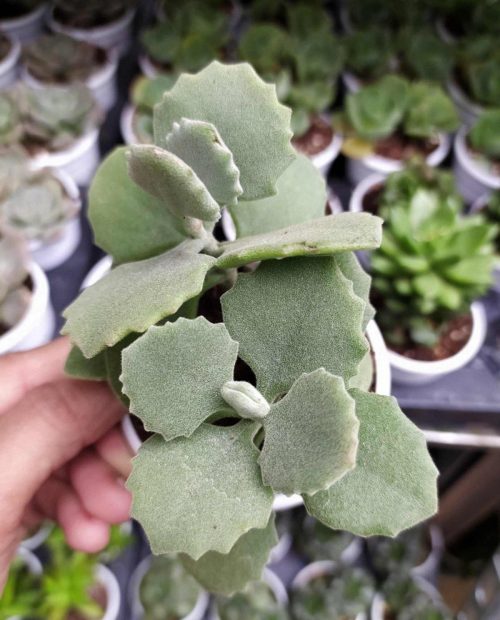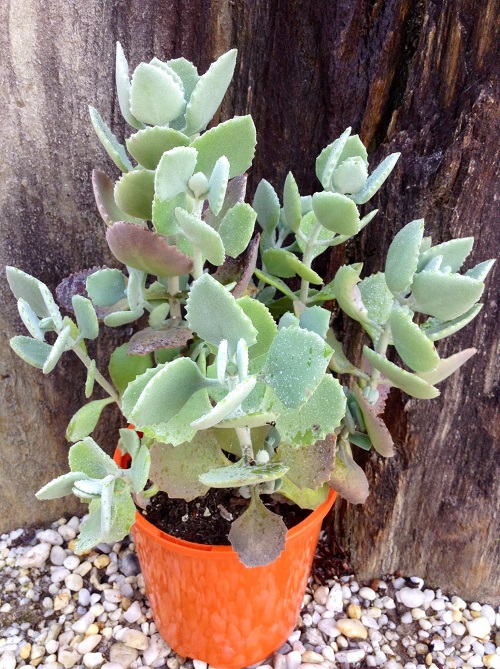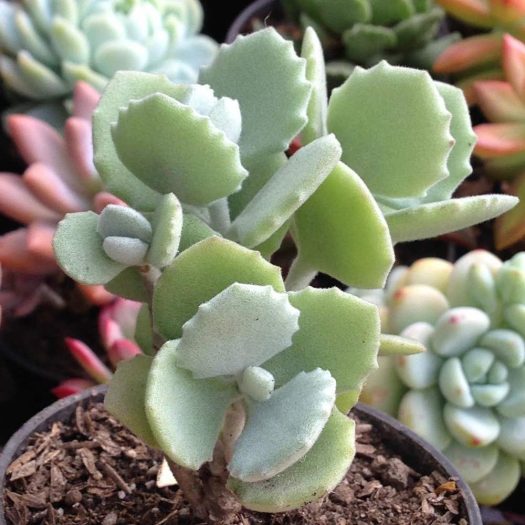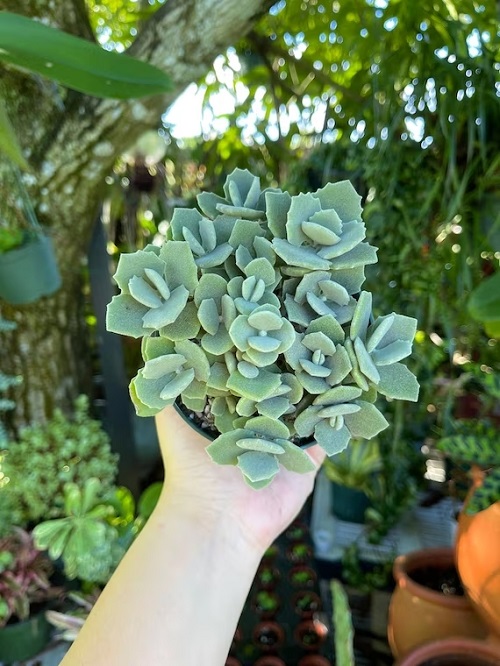Kalanchoe Millotii – a cute little succulent with leaves that look straight out of a science fiction! Here’s all about this stunning plant!
Kalanchoe Millotii—a mesmerizing plant with a foliage that’s akin to soft velvet and carries a silver sheen. Known for its low-maintenance care routine and stunning aesthetic, this captivating succulent is great for small spaces!
Check out the Best Types of Flowering Kalanchoe Varieties here
Kalanchoe Millotii Information
Native Habitat
Kalanchoe Millotii is native to Madagascar, where it thrives in arid, rocky landscapes. Its origins in this environment make it particularly well-suited for indoor and outdoor cultivation in various settings.
Foliage
The leaves of the Kalanchoe Millotii grow in a rosette formation and can reach lengths of 4-6 inches. The soft, silver-gray leaves are fleshy, storing water to help the plant survive in its native, arid conditions.
Flowers
While not particularly known for its flowers, Kalanchoe Millotii can bloom under the right conditions. When it does flower, expect to see small, inconspicuous, greenish-yellow blossoms that appear in clusters. The flowering period is usually in late winter to early spring but can vary depending on the growing conditions.
Unique Features
What sets Kalanchoe Millotii apart from other Kalanchoes is its distinctive, velvety leaves. The texture not only adds to the plant’s visual appeal but also serves a functional role, helping to reflect sunlight and conserve moisture.
Learn How to Force Kalanchoe to Flower More here
Propagating Kalanchoe Millotii
Methods to propagate Kalanchoe Millotii:
- Leaf Cuttings
- Offsets or Pups
- Stem Cuttings
Leaf Cutting is the easiest method of propagation.
- Choose a healthy, mature leaf from the parent plant. Ensure it is free from damage or disease.
- Place the leaf on a dry surface and allow the cut end to air dry and form a callus. This usually takes a day or two.
- Prepare a well-draining potting mix. You can use cactus or succulent potting mix or create your own mix with sand, perlite, and potting soil.
- Insert the callused end of the leaf about 1 inch into the potting mix. Ensure the leaf is secure but not buried too deeply.
- Place the pot in a location with bright, indirect sunlight.
- Water sparingly and only when the top inch of soil is dry. Overwatering can lead to rot.
- Roots should start forming within a few weeks. After several weeks, you’ll notice new plantlets sprouting from the base of the leaf.
- Once the new plantlets have grown large enough to handle, transplant them into their individual pots or your desired garden location.
Propagate Any Plant Cutting Quickly Using this Trick
Best Pot Size for Growing Kalanchoe Millotii
For Kalanchoe Millotii, choose a pot that is 6-8 inches in diameter, which will be good for a few years to come. Based on its growth and spread, re-pot it into one size bigger pot than the old one when the need arises.
Check out Beautiful Kalanchoes on Instagram here
Requirements for Growing Kalanchoe Millotii
Light
Place it near a south or west-facing window where it can receive filtered sun or dappled light for at least 5-6 hours every day. Protect it from the harsh midday sun, as intense light can scorch its delicate foliage.
Soil
Kalanchoe Millotii thrives in well-draining soil, such as cactus or succulent potting mix. You can also make your own potting mix at home using:
- Coco Coir or Peat Moss: 40% – Provides excellent water retention and aeration.
- Perlite or Pumice: 40% – Ensures good drainage and aeration, preventing root rot.
- Compost: 20% – Adds essential nutrients to the soil.
Check Beautiful Kalanchoe Types & Varieties You Should Grow here
Water
Water Kalanchoe Millotii sparingly, allowing the top inch of soil to dry between watering. Water at the base of the plant, avoiding wetting the foliage.
Overwatering can lead to root rot, so ensure well-draining soil and pots with drainage holes.
Temperature and Humidity
Kalanchoe Millotii grows well in a warm environment with temperatures between 60°F and 85°F (15°C to 31°C). It thrives in moderate indoor humidity levels, around 40-50%.
Avoid exposing it to drafts or extreme temperature fluctuations, as it’s sensitive to cold. Maintaining these conditions ensures the healthy growth of the plant.
Kalanchoe Millotii Care
Fertilizer
A balanced liquid fertilizer, with a ratio of 20-20-20, works well for Kalanchoe Millotii. Dilute it to 1/2 of its strength and use it once in 3-4 weeks – it will boost the size of the leaves.
During fall and winter, stop fertilizing entirely as the plant’s growth slows down.
Pests and Diseases
Kalanchoe Millotii is generally hardy but can suffer from mealybugs, aphids, or scale insects. To prevent these pests, regularly inspect your plant and use an insecticidal soap or neem oil to get rid of them.
Watch for root rot due to overwatering and ensure to use well-draining soil.
Learn How to Grow Flowering Kalanchoe Indoors here
Kalanchoe Millotii Display Ideas
- Window Sills: Placing the plant near a well-lit window allows it to catch natural light, highlighting its unique foliage.
- Shelves or Tables: Elevate Kalanchoe Millotii by placing it on a stylish shelf or tabletop that complements your interior décor.
- Solo Star: The Kalanchoe Millotii can stand alone as a statement piece due to its unique appearance.
- Mixed Arrangements: Pair it with other succulents or cacti of varying heights and shapes for a desert-inspired look.
- Decorative Stones: Consider layering decorative stones or pebbles on the soil surface for a polished appearance.
- Plant Stands: Utilize modern or rustic plant stands to highlight Kalanchoe Millotii as a focal point in the room.
- Trays and Mats: Place the pot on a decorative tray or mat to capture any excess water and add an extra layer of style.
- Backdrop: If the plant is placed against a wall, choose a wall color that complements or contrasts with the plant for a dynamic display.
- Spotlight: For added drama, place a small spotlight near Kalanchoe Millotii to illuminate its unique leaf texture.
- Holiday Themes: Incorporate seasonal décor elements like fairy lights during the holidays to make your Kalanchoe Millotii a part of the festivities.
Check Tricolor Houseplants with Fantastic Foliage here
Kalanchoe Millotii – FAQs
Q: How often should I repot my Kalanchoe Millotii?
Answer: Repot Kalanchoe Millotii when it outgrows its current container, typically every 2-3 years. Choose a pot slightly larger than the current one with good drainage.
Q: Is it safe to use Kalanchoe Millotii as an indoor plant around pets?
Answer: While Kalanchoe Millotii is not highly toxic, it’s best to keep it out of reach of pets as ingestion can lead to mild stomach upset. Monitor its placement around curious pets.
Q: Can Kalanchoe Millotii be grown outdoors in colder climates?
Answer: It’s generally suitable for outdoor growth in USDA hardiness zones 10-11. In colder regions, it’s best grown as an indoor plant or in containers that can be brought indoors during winter.






